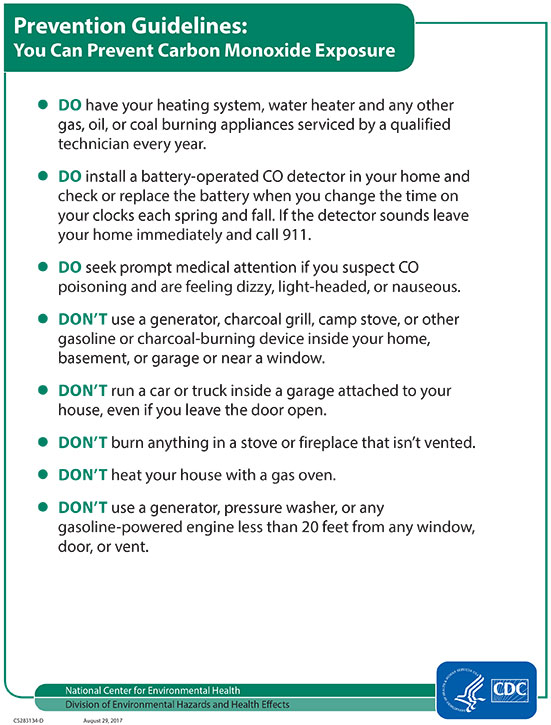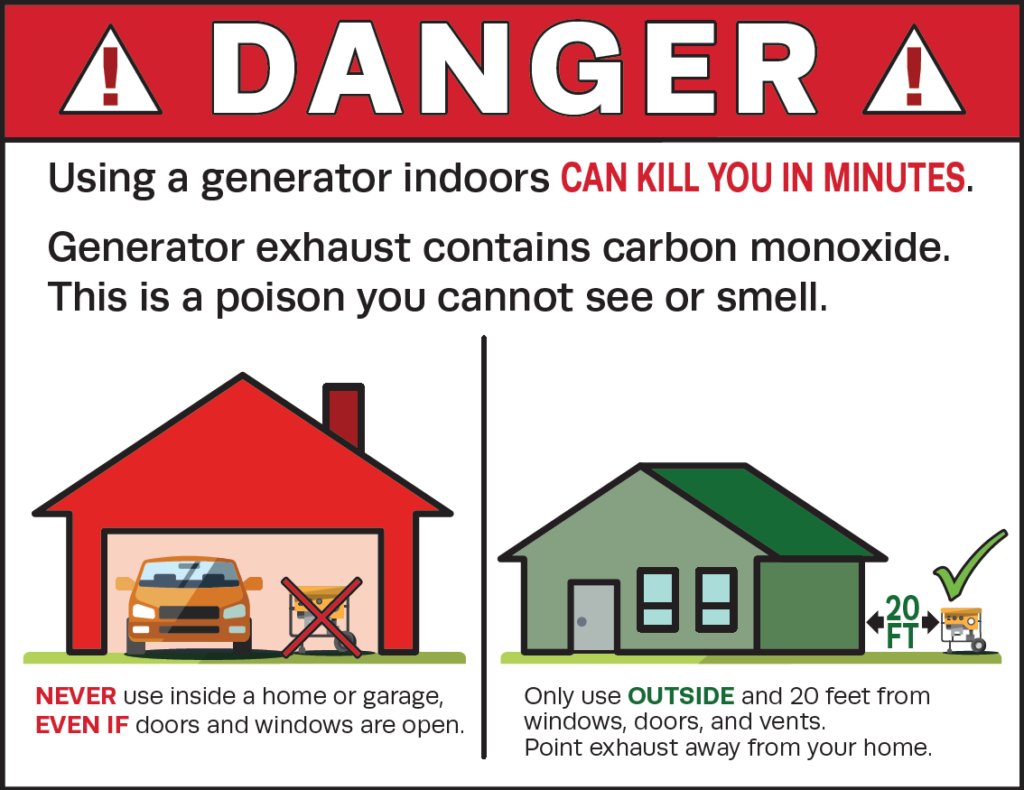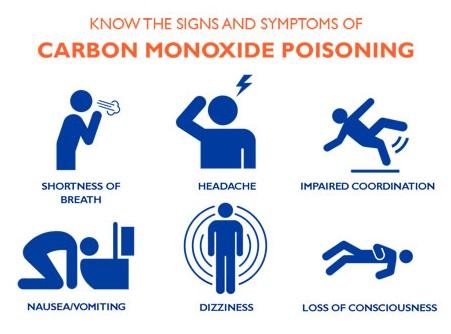Yes, an open window can help reduce carbon monoxide, but may not be sufficient. Adequate ventilation is crucial with any carbon-based fuel burning.
In indoor environments where unflued heaters are in use, such as those powered by gas or wood, proper ventilation through open windows is necessary to mitigate carbon monoxide buildup. This odorless and colorless gas poses serious health risks, and while opening a window can aid in dispersing it, relying solely on ventilation isn’t a foolproof solution.
Understanding the importance of ventilation to prevent carbon monoxide poisoning is essential for maintaining a safe indoor environment. By ensuring proper airflow and ventilation, the risk of carbon monoxide accumulation can be minimized, safeguarding occupants’ health and well-being.

Credit: www.cdc.gov
The Dangers Of Carbon Monoxide
Carbon monoxide is a toxic gas that is odorless, colorless, and tasteless, making it extremely dangerous. Exposure to high levels of carbon monoxide can lead to serious health issues and even death. Understanding the risks associated with carbon monoxide poisoning is crucial for keeping yourself and your loved ones safe.
Understanding Carbon Monoxide Poisoning
Carbon monoxide poisoning occurs when there is an accumulation of carbon monoxide in the air. This gas can interfere with the body’s ability to absorb oxygen, leading to symptoms such as headaches, dizziness, nausea, and even unconsciousness. In severe cases, carbon monoxide poisoning can be fatal.
Identifying Carbon Monoxide Sources
Carbon monoxide is produced by the incomplete burning of carbon-based fuels, such as gas, charcoal, wood, or kerosene. Common sources of carbon monoxide in homes include faulty furnaces, gas stoves, fireplaces, and generators. It is essential to ensure that these appliances are properly maintained and that your home has sufficient ventilation to prevent the buildup of carbon monoxide.
Remember: Carbon monoxide is a silent killer that can pose a significant risk to your health and safety. Stay vigilant and take appropriate measures to protect yourself and your family from the dangers of carbon monoxide poisoning.
The Myth Of Open Windows
When it comes to addressing carbon monoxide exposure, many people believe that simply opening windows can effectively mitigate the risks. However, the effectiveness of this approach is often misconstrued. Let’s delve deeper into the myth of open windows.
Exploring The Effectiveness Of Open Windows
Opening windows can indeed help in reducing carbon monoxide levels in a room, but the extent to which it can effectively eliminate the gas is often overestimated. It is crucial to understand the limitations of this method and explore more comprehensive strategies for ventilation.
Debunking Misconceptions
- While opening windows can provide some fresh air circulation, it may not be sufficient to completely eradicate carbon monoxide buildup.
- Carbon monoxide is a heavy gas that lingers and spreads quickly, making it challenging for simple window ventilation to fully address the issue.
- Contrary to popular belief, cracking a window alone may not offer adequate protection against carbon monoxide poisoning.
In conclusion, while opening windows can be a part of a broader ventilation strategy, it is essential to recognize its limitations in dealing with carbon monoxide exposure effectively. By debunking the misconceptions surrounding the myth of open windows, we can better protect ourselves from this silent and deadly threat.
Effective Ways To Minimize Carbon Monoxide
Carbon monoxide (CO) is an odorless, colorless gas that can pose serious health risks if not properly managed. To minimize the risk of carbon monoxide exposure in your home, there are several effective measures you can take. From utilizing carbon monoxide detectors to ensuring proper ventilation and maintenance, these measures can help safeguard your household from the potential dangers of CO.
Utilizing Carbon Monoxide Detectors
Installing carbon monoxide detectors in key areas of your home is an essential step in preventing CO exposure. These devices are designed to alert you to the presence of CO, giving you valuable time to evacuate and seek help. Be sure to place detectors near bedrooms and on every level of your home, and regularly test and replace the batteries to ensure they remain in working condition.
Proper Ventilation And Maintenance
Proper ventilation and maintenance of fuel-burning appliances is crucial for minimizing the risk of carbon monoxide buildup. Regularly inspect and clean vents, chimneys, and flues to ensure they are clear of obstructions and functioning efficiently. Additionally, have heating systems, water heaters, and other fuel-burning appliances serviced by a qualified technician annually to address any potential issues and ensure they are operating safely.
By incorporating these measures into your household routine, you can significantly reduce the risk of carbon monoxide exposure and create a safer living environment for you and your family.
Preventive Measures
When it comes to protecting your home and loved ones from carbon monoxide (CO) exposure, it’s crucial to take preventive measures. Creating a safe environment and following best practices for carbon monoxide safety are essential for minimizing the risks associated with this odorless and colorless gas. In this section, we will explore effective preventive measures you can implement to ensure the safety of your household.
Creating A Safe Environment
One of the primary ways to reduce the risk of carbon monoxide poisoning is to create a safe environment. Here’s what you need to do:
- Install carbon monoxide detectors on every level of your home, including inside and outside sleeping areas.
- Regularly test and maintain your carbon monoxide detectors to ensure they are functioning properly.
- Keep all fuel-burning appliances, such as furnaces, water heaters, and stoves, properly maintained.
- Ensure proper ventilation and airflow in areas where fuel-burning appliances are located.
- Never operate gas-powered generators, grills, or other fuel-burning equipment inside your home or enclosed spaces.
Best Practices For Carbon Monoxide Safety
In addition to creating a safe environment, following these best practices for carbon monoxide safety can further minimize the risks:
- Regularly inspect and maintain your chimney and flue to ensure proper ventilation and prevent any blockages.
- Avoid using unvented gas or kerosene space heaters, as they increase the risk of carbon monoxide buildup.
- Do not leave your car running inside the garage, even with the garage door open.
- Teach everyone in your household about the symptoms of carbon monoxide poisoning and what to do if they suspect exposure.
- Ensure that all fuel-burning appliances are properly installed by a qualified professional.
By following these preventive measures and best practices, you can significantly reduce the risk of carbon monoxide poisoning in your home. Remember, your safety and the safety of your loved ones should always be a top priority.
Final Thoughts
Carbon monoxide (CO) is a silent killer that can be deadly if not detected in time. Opening a window can help to reduce the levels of CO in a room, but it may not be enough to fully protect you and your loved ones. It is crucial to raise awareness about the dangers of carbon monoxide and take appropriate action to prevent exposure.
Raising Awareness And Taking Action
One of the most important steps in preventing carbon monoxide poisoning is to raise awareness about its dangers. Many people are unaware of the risks associated with CO and may not take the necessary precautions. By educating others about the sources of CO, the symptoms of poisoning, and the importance of having carbon monoxide detectors in their homes, we can help to prevent accidents and save lives.
Additionally, taking action to reduce the risk of carbon monoxide exposure is essential. Here are some steps you can take:
- Install carbon monoxide detectors on every level of your home, especially near sleeping areas.
- Regularly test and replace the batteries in your CO detectors to ensure they are functioning properly.
- Have all fuel-burning appliances, such as furnaces and water heaters, inspected and serviced regularly by a professional.
- Never use portable generators, camp stoves, or grills indoors.
- Ensure proper ventilation when using gas-powered tools or equipment in enclosed spaces.
- Avoid running your car in an enclosed garage, even with the garage door open.
- If you suspect carbon monoxide poisoning, leave the area immediately and seek professional help.
Seeking Professional Help
If you believe there is a carbon monoxide leak in your home or are experiencing symptoms of poisoning, it is crucial to seek professional help right away. Contact your local fire department or a qualified technician who can assess the situation and take the necessary steps to ensure your safety. Do not try to handle the situation on your own, as carbon monoxide can be extremely dangerous.
Remember, opening a window can help to dilute the carbon monoxide in a room, but it is not a foolproof solution. Taking proactive measures, raising awareness, and seeking professional help when needed are key to protecting yourself and your family from the dangers of carbon monoxide.

Credit: twitter.com

Credit: www.onlinesafetytrainer.com
Frequently Asked Questions Of Carbon Monoxide Open Window
Will Having A Window Open Prevent Carbon Monoxide?
Yes, opening a window can help reduce carbon monoxide, but it may not be sufficient if there’s an unflued heater using carbon-based fuel. Ventilation is critical in such cases to prevent carbon monoxide buildup.
Does Opening Windows Get Rid Of Co2?
Yes, opening windows can help reduce CO2 levels, but it may not fully eliminate them. Adequate ventilation is crucial to prevent buildup in enclosed spaces with carbon-based fuel sources.
How Long Does It Take For Carbon Monoxide To Air Out Of Your House?
To air out carbon monoxide from your house, open windows for at least 4-6 hours. A well-ventilated room is crucial for safety.
How Do You Reduce Carbon Monoxide In A Room?
To reduce carbon monoxide in a room, ensure good ventilation by opening windows and using exhaust fans. Maintain heating systems and appliances regularly.
Can Opening A Window Prevent Carbon Monoxide Poisoning?
Yes, opening a window can help to prevent carbon monoxide poisoning, but it may not be sufficient on its own. It is crucial to have proper ventilation when using any carbon-based fuel.
Conclusion
While leaving the window open can help reduce the risk of carbon monoxide poisoning, it may not eliminate it entirely. It’s crucial to prioritize proper ventilation and address the source of carbon monoxide to effectively mitigate the risks. Ensuring the safety of your living environment is always a top priority, and taking proactive measures is essential.
